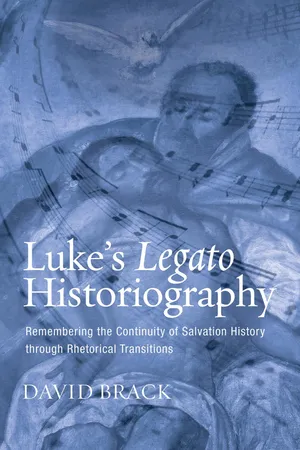![]()
1
Methodology
In order to prove my central proposal, I will implement a new socio-rhetorical methodology which uniquely blends memory theory and ancient rhetorical criticism. This methodology will be developed in the current chapter, and then in the following chapter I will examine how this methodology can provide a fresh reading of Luke-Acts within the specific socio-historical context of Luke’s listening audience(s). This background work will then set the stage for the remainder of this study (chapters 3 to 6), in which I will examine the four primary rhetorical transitions developed by Luke to assist his audience(s) in fully comprehending the continuity of salvation history.
Concerning the socio-rhetorical tools to be used in this investigation, it will work well to begin with the more general universal tendency of humans to manufacture continuity between past memories in order to shape their present identity. It will be observed how social memory theory provides extremely helpful language to describe the types of connections Luke develops in his historiography. This examination of social memory theory will then be followed by a more narrow look at how the ancient Greeks and Romans made these types of mental connections in their narratives. I will examine ancient historians and rhetoricians from Aristotle to Lucian, noting their tendency to shape past memories into a continuous narrative. I will then locate Luke within this ancient literary context, focusing attention on the primary rhetorical method utilized by Luke to remember the past as a continuous narrative—rhetorical transitions. It will be shown in this chapter how both the tools of social memory theory and rhetorical criticism collectively can improve our understanding of how Luke specifically has arranged his narrative to reassure his audience of the continuity of salvation history. These two disciplines can work together to provide a rich new reading of Luke-Acts. In other words, ancient rhetoric provides the skeletal framework of the text while social memory theory places working organs within this structure and wraps it in warm skin.
Social Memory Theory
To begin, therefore, I will describe some aspects of social memory theory. As the name suggests, social memory theory is essentially concerned with the social dimensions of memory, particularly with the manner that present social realities influence the ways groups envision and use the past. “Memory” refers broadly to any means by which a group attempts to preserve the past. Social memory theory rests on the premise that the act of “remembering” cannot be reduced to a simple recall of information by isolated individuals, but rather is always a complex group phenomenon. Social memory theory has developed its vocabulary and insights from a variety of disciplines that explore how humans deal with the past. Such disciplines include sociology, psychology, anthropology, neurology, linguistics, philosophy, and history.
The systematic study of collective memory began with the seminal work of French sociologist Maurice Halbwachs in the 1920s (On Collective Memory). While there are certainly precursors to the memory studies of Halbwachs, his work offers a convenient starting point regarding more recent trends in memory studies. Halbwachs noted that to remember is not to retrouver, but to reconstruire, aligning the image of the past with the present social realities. He rejected previous “passivist” models, which viewed all memories of the past as replicative of the events themselves and the contribution of the remembering subject as primarily passive. Rather, Halbwachs spoke of memory as present social constructions of the past, based on current needs and present preoccupations. These preoccupations will determine what is commemorated, or conversely, what is forgotten. Since the present (and its concerns and preoccupations) is ever-changing, so the memory frameworks of a community are constantly in flux. Therefore, immutability in the representation of the past is never achieved, but rather as stated by Jan Assmann “the past is continually being reorganized by the constantly changing frames of reference of the ever-evolving present.” Or as stated by Barry Schwartz, “a charismatic epoch is not a fixed entity which imposes itself on the present; it is a continuously evolving product of social definition.”
This focus on tendentious shaping of the past, however, was pushed to its limits at the end of the twentieth century. Eric Hobsbawm and Terrence Ranger have popularized the phrase “invention of tradition” in contemporary dialogue. They speak of tradition as mostly fabricated, either de novo or out of the remains of the past. Likewise, Handler and Linnekin argue that “tradition” and “pastness” are constructed completely in orientation to the present. “Constructionists,” such as Handler and Linnekin, argue that the sense of continuity between the past and present is fabricated by the hegemonic and idealogical interests that produce the constructed past. Others have adopted this rather one-sided understanding of memory.
Recently, many have rightly pushed back on this extremist approach to memory, resisting the temptation to take this as an axiomatic point of departure. Research has begun to demonstrate that the past is not simply a smorgasbord from which to pick and choose in order to construct one’s memories of history. Rather, many have begun to recognize that the present is also influenced by the past. Yael Zerubavel rightly notes “invented tradition can be successful only as it passes as tradition.”
While all societies remember the past, what they remember about the past is largely determined by the traditions it has inherited. It has been stated,
Therefore, in contrast to the more extreme constructionist position, it has become clearer that “both present social...
